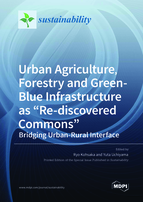Urban Agriculture, Forestry and Green-Blue Infrastructure as “Re-discovered Commons”: Bridging Urban-Rural Interface
A special issue of Sustainability (ISSN 2071-1050). This special issue belongs to the section "Sustainable Forestry".
Deadline for manuscript submissions: closed (31 December 2020) | Viewed by 26588
Special Issue Editors
Interests: landscape approach to forestry; resource management; geographical indications
Special Issues, Collections and Topics in MDPI journals
Special Issue Information
Dear Colleagues,
With pleasure, we would like to invite researchers in the fields of urban/agricultural planning, ecology, agriculture and forestry science with multi-disciplinary approach to submit papers to the special issue.
We welcome submissions on evaluations of cultural and recreational ecosystem services or Nature’s Contribution to People. The topics will include access to green areas, access and challenges to urban agricultural lands, justice and resilience of the community, inclusive environmental managements, traditional ecological knowledge, volunteer activities and their labour (in depopulating/aging society for Asia).
Furthermore, we include the scope of rural areas which is facing serious depopulation, aging, collapse of tourism, and changes in material flows and productions. Here, our focus is on how resilience of the community in contexts of urban-rural linkage. The rural areas are also experiencing transformative changes to face the challenges by IoT technologies, sharing traditional knowledge, protecting the common regional added value traditional products (i.e. products of Geographical Indications) and agricultural heritage and related regional designations (i.e. the Globally Important Agricultural Heritage Systems (GIAHS), the Man and the Biosphere Programme (MAB) and etc.).
The topics include urban-rural collaborations, practice of LCA assessments of new modus of productions, moves to share brands (such as geographical indications or trademarks), alternative community-based agriculture, organic agriculture in collaboration with urban residents). As an example of urban-rural collaboration, the flow of timbers has changed due to decreased demands for housing and there has been movements to create demands in urban areas to support upper rural areas in river-basin scale.
One of the fields in the special issue is the meaning of “shared green parks, green, agricultural, forest areas, and other natural resources in urban and rural areas” during and after the COVID-19 crisis in 2020. The crisis uplifted the important to those without gardens and served as “oasis for the poor” in some cases and it changed the relationships between urban and rural areas.
Prof. Dr. Ryo Kohsaka
Dr. Yuta Uchiyama
Guest Editors
Manuscript Submission Information
Manuscripts should be submitted online at www.mdpi.com by registering and logging in to this website. Once you are registered, click here to go to the submission form. Manuscripts can be submitted until the deadline. All submissions that pass pre-check are peer-reviewed. Accepted papers will be published continuously in the journal (as soon as accepted) and will be listed together on the special issue website. Research articles, review articles as well as short communications are invited. For planned papers, a title and short abstract (about 100 words) can be sent to the Editorial Office for announcement on this website.
Submitted manuscripts should not have been published previously, nor be under consideration for publication elsewhere (except conference proceedings papers). All manuscripts are thoroughly refereed through a single-blind peer-review process. A guide for authors and other relevant information for submission of manuscripts is available on the Instructions for Authors page. Sustainability is an international peer-reviewed open access semimonthly journal published by MDPI.
Please visit the Instructions for Authors page before submitting a manuscript. The Article Processing Charge (APC) for publication in this open access journal is 2400 CHF (Swiss Francs). Submitted papers should be well formatted and use good English. Authors may use MDPI's English editing service prior to publication or during author revisions.
Keywords
- Sharing
- Access to Green Areas
- Urban Agriculture
- Green-Blue Infrastructure
- Urban-Rural Collaboration
- Transitional Management
- Traditional Ecological Knowledge
- COVID19 crisis







